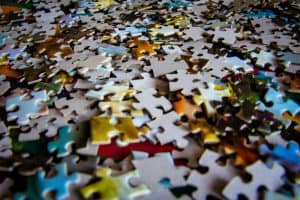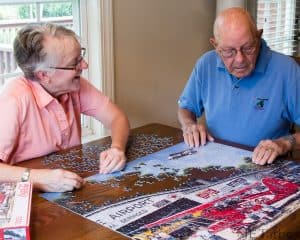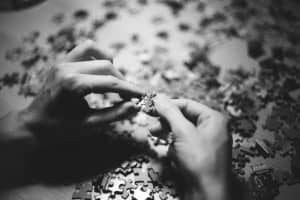The jigsaw puzzle craze isn’t just a fleeting trend; it’s a fascinating journey through time that has captured the hearts of many. From its humble beginnings as educational tools in the mid-1700s to becoming the ultimate form of entertainment for adults in the early 20th century, puzzles have come a long way.
I’ve seen firsthand how the allure of fitting those intricate pieces together can turn into a passion. It’s not just about the challenge; it’s the sense of accomplishment and the unexpected benefits that come with it. Whether you’re a seasoned puzzle master or new to the scene, there’s no denying the captivating charm of the jigsaw puzzle craze.
The Origins of Jigsaw Puzzles

The first jigsaw puzzle traces back to the 1760s, a creation of John Spilsbury, an engraver and mapmaker. He ingeniously adhered maps to wood, cutting them into pieces. It was a tool aimed to teach geography to children, a far cry from its widespread entertainment appeal today. This educational idea bloomed into a craze beyond instructional aids. Puzzles evolved, capturing jigsaw puzzle images ranging from historical figures to enchanting landscapes. By the time of the Great Depression, puzzles were not just for kids or geography lessons but became popular pastimes for adults, mirroring a society finding solace and challenge in fitting together piece by piece.
The transformation didn’t stop there. With advances in manufacturing, cardboard replaced wood, making puzzles more accessible and affordable. This shift coincided with a boom in puzzle popularity, marked by the formation of puzzle clubs and puzzle contests. The idea of puzzles as mere educational games for children with smaller hands was quickly becoming a forgotten notion. Instead, jigsaw puzzles were celebrated for their complexity and the pleasing image they revealed upon completion, becoming part of the fabric of popular choices in entertainment.
Fast forward to the coronavirus pandemic, and we find the jigsaw puzzle craze resurging, stronger than ever. Locked in homes, millions turned to puzzles, not just as a way to pass time but as a method to detach from the digital overload and connect with a tactile, puzzle mania. Weekly jigsaw puzzles became a thing, and social media platforms saw hashtags related to puzzles reaching unprecedented views.
The pandemic reignited the feeling of triumph in putting the final piece in place, reminding adults and children alike of the joy in small victories, one puzzle piece at a time. Puzzles, once a method to teach geography, now serve as a testament to the human spirit’s resilience, demonstrating how, much like life’s problems, everything fits together eventually.
The Rise in Popularity
As I delve into the history of the jigsaw puzzle craze, it’s fascinating how this simple idea of cutting up pictures into pieces has captivated generations. Jigsaw puzzles have been a staple of entertainment since their inception, evolving from educational tools designed to teach geography to children in the 18th century to becoming popular choices for leisure among adults. It all began with John Spilsbury, who created the first jigsaw puzzle by mounting a map on wood and cutting it into pieces. This concept of “dissected maps” quickly caught on, laying the groundwork for the puzzle craze that would sweep through the centuries.
In the early days, puzzles were mostly hand-cut, catering to a more affluent audience. However, with technological advances, like the treadle jigsaw and improvements in printing techniques, puzzles became more affordable and accessible to the general public. The innovation of cardboard puzzles further democratized this pastime, allowing for mass production and a wider reach. It wasn’t just about maps or pleasing images; puzzles began to depict movie stars, historical images, and even political cartoons, reflecting society’s interests and the zeitgeist of each era.
The appeal of jigsaw puzzles surged again during significant historical moments when people turned to puzzles as a form of comfort and escape. Notably, during the Great Depression, puzzles served as inexpensive entertainment and a distraction from the harsh economic situation. Fast forward to the recent coronavirus pandemic, and we witnessed a similar resurgence in puzzle popularity.
The challenge of piecing together a world disrupted by uncertainty brought solace to many, reigniting the jigsaw puzzle fever. Adults and children alike found joy in the simple pleasure of turning a pile of pieces into a coherent whole, a metaphor, perhaps, for piecing together life’s problems. With each era, jigsaw puzzles have proven to be more than just games; they are a reflection of resilience, creativity, and the human desire to solve and connect.
The Benefits of Doing Jigsaw Puzzles

I’ve seen firsthand how the jigsaw puzzle craze has swept across all age groups, becoming one of the most loved leisure activities, especially in light of the coronavirus pandemic. Jigsaw puzzles aren’t just another game tucked away on the shelf; they are an immersive challenge that offers more than just the satisfaction of placing the final piece. The complex designs and diverse themes, from beautiful landscapes to historical images, make every jigsaw puzzle a journey through art and history.
Sales of puzzles have soared, indicating a surge in puzzle mania. Adults and children alike find joy and a sense of accomplishment in completing a puzzle. For younger participants, puzzles specifically designed for smaller hands help develop motor skills and problem-solving abilities. Puzzle manufacturers have ingeniously tapped into the nostalgia factor by reviving forgotten images or depicting movie stars, political cartoons, and dissected maps, further fueling the puzzle craze.
How to Choose the Right Puzzle
With the jigsaw puzzle craze hitting new heights, especially during the coronavirus pandemic, it’s no wonder everyone’s looking to get their hands on the next challenge. Choosing the right puzzle, one that perfectly suits your interest, skill level, and the harmlessly addictive pleasure of the activity, is key to fully engaging with this trend. The first jigsaw puzzle, with its hand-cut wooden pieces, might have been a map designed to teach geography. But today’s puzzle offerings are vast and varied, featuring everything from enchanting landscapes and historical images to weekly jigsaw puzzles depicting movies stars and political cartoons.
When I consider a new puzzle, I always start by looking at the piece count – a crucial point that can make or break the puzzle experience for me. For adults, puzzles ranging from 500 to 1,000 pieces are popular choices, offering the right level of challenge without tipping into frustration. Meanwhile, puzzles with larger, more manageable pieces are best for children or those with smaller hands, ensuring everyone can join in on the fun. My idea of a perfect afternoon is diving into a new puzzle challenge, one piece at a time, allowing the chaos of the outside world to fade away.
But the choice doesn’t stop there. Puzzle images play a massive role in the selection process too. Whether it’s the breathtaking view from a recent vacation hotspot, revered artworks, or forgotten maps, the image should hold some personal appeal, enhancing the overall enjoyment. Puzzle fever isn’t solely about the challenge; it’s also about constructing a pleasing image that, once completed, offers a deep sense of accomplishment and, perhaps, a beautiful new piece of art for your living space.
Finding the right puzzle might seem like an easy task, but as someone caught up in the puzzle mania, I can attest that considering the piece count, the size of the pieces, and the image itself can turn a simple puzzle into an immersive journey. This attention to detail reinforces why puzzles have become such a beloved pastime, transcending age and time to remain a staple in both leisure and learning. Whether for educational purposes or as a solace from life’s problems, the right jigsaw puzzle can offer hours of satisfying entertainment, truly making it one of the most timeless and universal games.
Tips and Tricks for Solving Puzzles

With the jigsaw puzzle craze showing no signs of slowing down, especially during the coronavirus pandemic, I’ve found some strategies that have transformed me from a puzzled novice into a confident puzzle solver. The surge in popularity isn’t just about killing time; it’s a means of challenge, a momentary escape from life’s problems, and for some, a dip into nostalgia where dissected maps and historical images once reigned supreme.
My first piece of advice is to familiarize yourself with the puzzle images. Weekly jigsaw puzzles often feature themes or repeating elements, and recognizing these can help you predict the piece arrangement. Start with the edges, a popular choice among enthusiasts, to build out the frame. From there, grouping pieces based on colors, patterns, or specific parts of the jigsaw puzzle images can make the task less daunting.
Another vital point is considering the puzzle cut and the material. The first jigsaw puzzle was hand-cut from wood, a tradition that has evolved with most puzzles now made from cardboard, catering to both adults with nostalgia for that tactile feel and children with smaller hands. Puzzle manufacturers have also introduced varied piece shapes and sizes, adding another layer of challenge. This shift has made puzzle pieces more unique, ensuring that every placement is intentional and further fueling the puzzle mania.
For those new to the craze or returning after a long time, remember, the goal isn’t merely to complete the puzzle but to enjoy the journey. Whether you’re participating in puzzle contests, joining puzzle clubs, or simply settling in for a quiet evening of piece work, the satisfaction lies in watching a pleasing image emerge from chaos. And, as sales have surged during the pandemic, it’s evident that the solace found in puzzles—be it as educational games, a form of meditation, or social activity—resonates widely, proving the enduring puzzle popularity.
Final thoughts: Jigsaw Puzzle Craze
The enduring appeal of jigsaw puzzles, from their historical roots to their role as a modern-day comfort and educational tool, is undeniable. I’ve seen firsthand how these intricate pieces of art have not only stood the test of time but also evolved to meet the changing needs and interests of society. The recent surge in popularity, especially during challenging times, highlights puzzles’ unique ability to bring people together, offering both a sense of achievement and a much-needed escape.
As we navigate the vast selection of puzzles available today, it’s clear that finding the right one can transform this pastime into an enriching journey. Whether it’s the satisfaction of placing the final piece, the cognitive benefits, or the simple joy of the process, the world of jigsaw puzzles offers something for everyone. It’s more than just a craze—it’s a testament to the human desire for connection, challenge, and joy.

